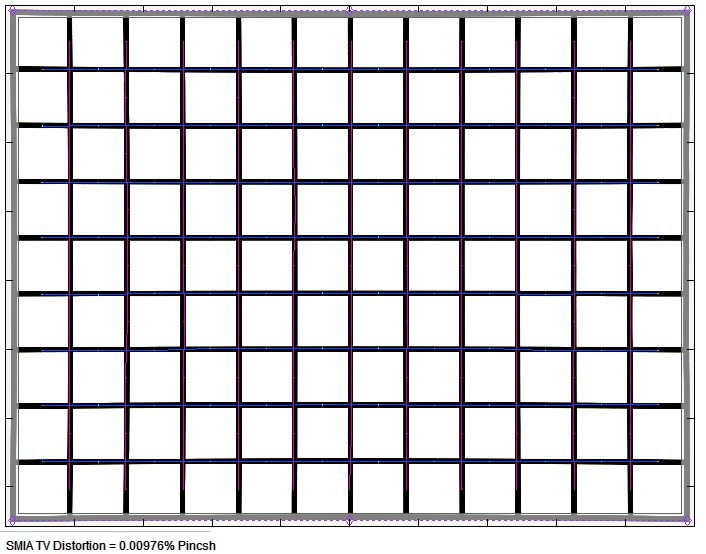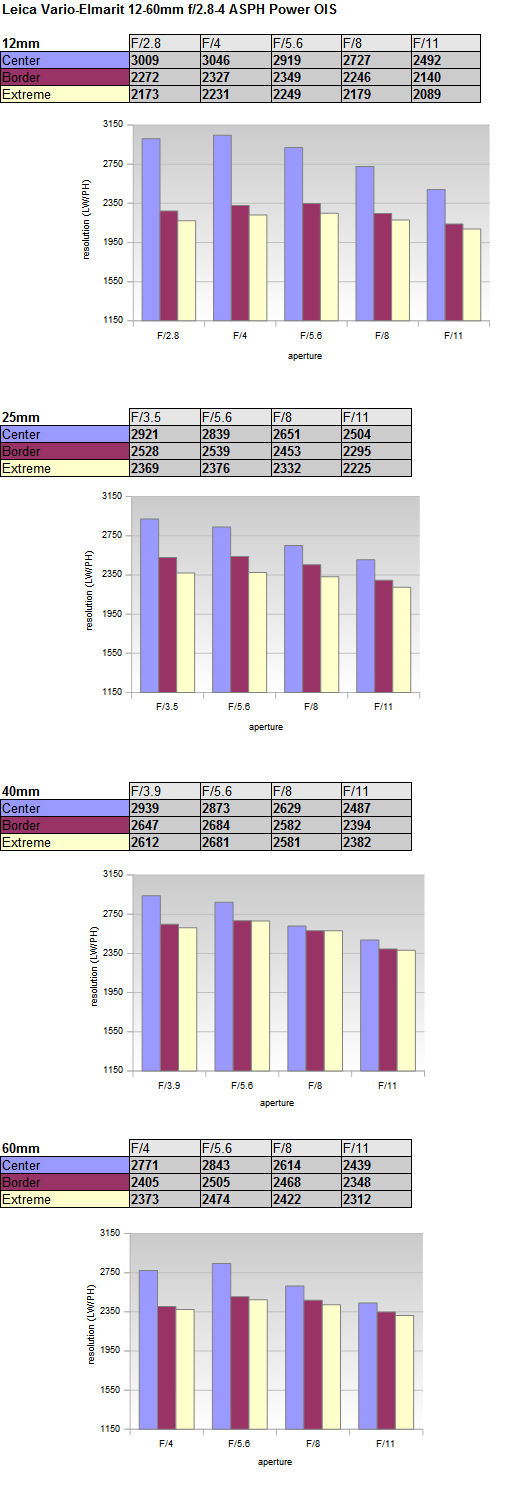
The Micro-Four-Thirds (MFT) system is blessed by having two primary manufacturers. Their combined lineup is highly impressive by now and their standard zoom segment is especially crowded. Olympus is contributing lenses with three quality grades to the system and Panasonic adds at least two more – native Panasonic and Leica-branded lenses. The exact terms of the cooperation with Leica is not known but the Leica brand is certainly adding some poshness to MFT. One the the latest offsprings of this marriage is the Leica DG Vario-Elmarit 12-60mm f/2.8-4 ASPH Power OIS (gasp). Just to explain the “Vario-Elmarit” portion of the name – Vario refers to a zoom lens and an Elmarit is a lens with a max aperture of f/2.8. Surprisingly the Leica lens doesn’t come with the usual Leica price tag although it’s still not cheap either at around 1000EUR/US$.
The Leica lens is targeting the high-end of the market and this is reflected in the quality of the construction which is a step above Panasonic’s usual offerings. The lens body is mostly made of metal which feels quite classy. The zoom- and focus-rings operate smoothly. Typical for most standard zoom lenses it extends when zooming towards the long end of the range. The inner tube doesn’t wobble even when fully extended. The lens is also weather-sealed and “frost-proof” down to -10C. Unlike most of the affordable Panasonic lenses, the Leica has a dedicated AF and OIS switch. A petal-shaped lens hood is part of the package.
If you “shake” the lens you may notice that it “rattles”. There’s nothing wrong with this – what you hear is (most likely) the focus group. If you half press the shutter release button (in AF mode), the rattling is in fact gone – thus the AF group is tightly kept in place when doing so. The focus group seems to have a relaxed setup in order to allow speedy focusing. Fujifilm lenses have a similar design.

The AF motor is, as mentioned, very fast and noiseless. As usual manual focusing works “by wire” but you barely notice the difference compared to a mechanically-coupled system. Panasonic’s Power OIS (image stabilizer) offers a “gain” of around 2-3 f-stops (real life) which is somewhat less than we expected here. If you own one of Panasonic’s latest generation Lumix cameras, you can also take advantage of “Dual IS” thus the in-camera stabilizer can work in conjunction with the in-lens stabilizer. Panasonic doesn’t provide any figures here about it’s reasonable to assume an additional gain of 1.5-2 f-stops (we didn’t have a Panasonic camera to test this). While this is good in absolute terms, it stays short of Olympus’ Sync-IS (claimed up to 6.5 f-stops).
| Specifications | |
|---|---|
| Equiv. focal length | “24-120mm” (full format equivalent) |
| Equiv. aperture | “f/5.6-8” (full format equivalent in terms of depth-of-field) |
| Optical construction | 14 Elements in 12 Groups (4x Aspherical, 2xED) |
| Number of aperture blades | 9 (circular) |
| min. focus distance | 0.20m (1:3.33) |
| Dimensions (L x W) | 68.4x86mm |
| Weight | 320g |
| Filter size | 62mm |
| Hood | Petal-shaped, supplied, bayonet mount |
| Other features | Dust- and splash-proof, Freeze-proof (-10C), Nano-Surface Coating |
Distortion
The Micro-Four-Third system uses an automatic distortion-correction thus from a user perspective, there is little to worry about. The system doesn’t go for zero distortions but usually it’s good enough for sure. Regarding the Leica lens images show a moderate barrel distortion (1.6%) at 12mm and there’s barely something to report about beyond.




While most RAW converters as well as MFT cameras (JPEGs) don’t give you a choice, a few still do (e.g Capture One) thus it is possible to verify the original characteristic of the lens. With disabled auto-correction, the Leica lens shows a massive barrel distortion of 6.1% at 12mm. However, there’s barely any distortion in the middle range. At the far end you may notice a slight pincushion distortion in critical scenes.




Vignetting
Auto-correction is also applied to the vignetting characteristic. In this case, the system shows a relatively low degree (0.7 EV/f-stops) of light falloff at 12mm @ f/2.8 but there’s, again, barely any noticeable vignetting (0.5 EV or less) at other settings.

When looking behind the scenes again, the RAW vignetting is substantially different at 12mm only. At f/2.8 the light falloff is massive here and still obvious at f/4. At f/5.6 you may spot traces in certain scenes. However, the vignetting is mostly negligible in the 25-60mm range regardless of the aperture.

MTF (resolution)
Due to diffraction Micro-Four-Thirds tends to have its sweet spot around the f/2.8 mark (depending on the lens, of course). If you have a look at the following chart you will observe that the center quality is actually highest at one of the large aperture settings.
The Leica lens is generally a very good performer but it’s not flawless. At 12mm, the center quality is excellent at fully open aperture whereas the outer image field is “just” good. Stopping down to f/4 or f/5.6 doesn’t really improve the technical quality anymore. However, due to a bit of field curvature it is advisable to close the aperture by at least one stop in infinity depth-of-field scenes. As usual for MFT, you should avoid f/11 or beyond due to more pronounced diffraction effects. Remember that f/8 is already equivalent to “f/16” on full format camera when it comes to depth-of-field so it’s rarely necessary to go beyond anyway. The sweet spot of the lens is clearly in the middle range. At 18mm (not shown) and 25mm the borders are very sharp and the corners are at least good to very good. Zooming out the 40mm, the quality improves further with a tack sharp image across the image field at f/3.9 and f/5.6. There’s a slight decrease in resolution again at 60mm but the quality remain high here.
The tested sample had a good centering quality.
Please note that the MTF results are not directly comparable across the different systems!
Below is a simplified summary of the formal findings. The chart shows line widths per picture height (LW/PH) which can be taken as a measure of sharpness. If you want to know more about the MTF50 figures you may check out the corresponding Imatest Explanations.

Chromatic Aberrations (CAs)
Lateral CAs (color shadows at harsh contrast transitions) are low with an average CA pixel width below 1px at the image borders.

Bokeh
Micro-Four-Thirds may not be the hot-spot for shallow depth-of-field applications yet there’s still some potential if you can keep a fairly close focus distance – so let’s have a look at some details.
Out-of-focus highlights show an onion-like substructure. It’s not terrible but not good either. Most likely this relates to the extensive use of aspherical elements in the optical design. Stopping down emphasizes the effect somewhat.

The rendition of blur in the critical focus transition zone is not optimal. The blur is not symmetrical resulting in fairly hard edges. The more important background is smoother than the image foreground. Of course, these imperfections become obvious in scenes with harsh contrasts only.

Sample Images
Competition
The most obvious competitor of the Leica DG Vario-Elmarit 12-60mm f/2.8-4 ASPH Power OIS (to the left below) is its in-house cousin – the Panasonic Lumix G 12-60mm f/3.5-5.6 ASPH Power OIS (reviewed HERE) – shown in the right below. The Panasonic lens has obvious a smaller max. aperture and, consequently, a lower price tag but it’s actually a pretty good lens unless you need a fast aperture. Another competitor is the Olympus M.Zuiko 12-100mm f/4 IS PRO (center). It’s real world performance is similar but it’s a quite massive lens in comparison (review HERE). A better alternative is the Olympus M.Zuiko 12-40mm f/2.8 PRO (reviewed HERE) but its range is already substantially smaller and it doesn’t feature an image stabilizer.

Visual comparison courtesy of camerasize.com.
The Leica DG Vario-Elmarit 12-60mm f/2.8-4 ASPH Power OIS delivers a very good job without being brilliant - which is hardly surprising given its 5x zoom ratio. The resolution is perfectly fine (tack sharp) in the image center. However, like many MFT standard zoom lenses it suffers from aggressive distortion auto-correction at the wide end of the range which is limiting the border quality to max. good to very good results at 12mm. Due to field curvature you should also stop down a little here although this doesn't increase the technical performance anymore other than reducing corner noise (due to less vignetting compensation). The quality is great in the middle range and still impressive at 60mm. Lateral CAs are low and generally no issue. Vignetting and distortions are handled via image auto-correction so you don't need to worry about these two aspects in real life. The quality of the bokeh is a bit on the rough side.
The build quality is very high - the used materials are top-notch and everything is tightly assembled. The weather-sealing and a freeze-proof designs are reassuring. It's also very compact lens relative to it's zoom range and speed. The AF is very fast and absolutely noiseless. Panasonic Power OIS (optical image stabilizer) wasn't overly convincing unfortunately. It's hard to tell whether I'm a shaker or whether I have simply a different definition of critically sharp results but during the field session it gave me 2-3 f-stops max.
Coming to a final conclusion is difficult - less so because of the Leica lens itself but because there are so many MFT standard zoom lenses. It tries to find the "right" balance between range, quality and size and it certainly succeeds here in our opinion. Whether this specific balance is right for you is a different question.
-
Optical Quality
-
Build Quality
-
Price / Performance

